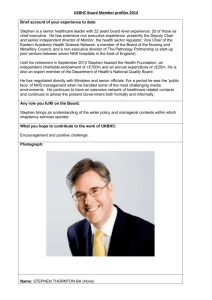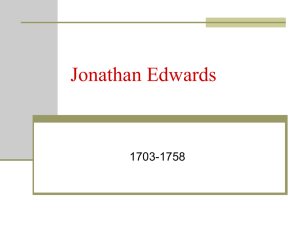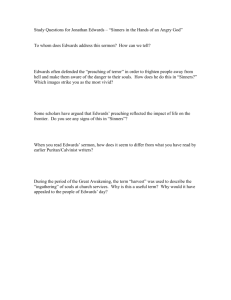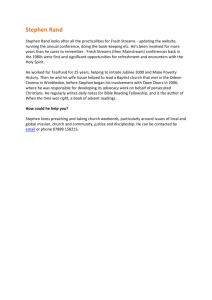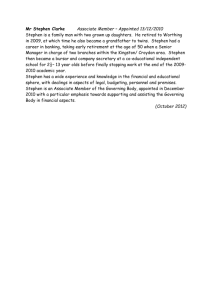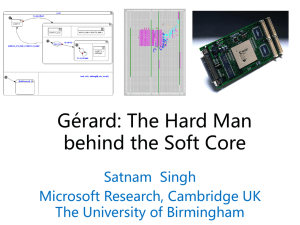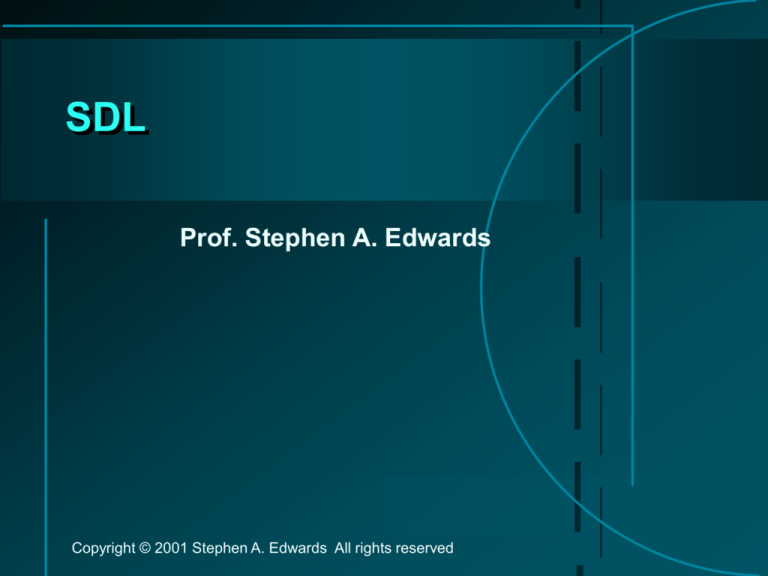
SDL
Prof. Stephen A. Edwards
Copyright © 2001 Stephen A. Edwards All rights reserved
The Most Generic Name Yet
SDL = Specification and Description Language
Grew out of the European telecommunications world
Good for describing protocols implemented on
distributed systems
Both textual and formal graphical syntax
Copyright © 2001 Stephen A. Edwards All rights reserved
Three Components in SDL Systems
System
•
•
•
Collection of concurrently-running blocks
Blocks communicate through explicit channels
Represents distributed, communicating computers
Block
•
•
•
Collection of concurrently-running processes or
collection of blocks
Blocks communicate through explicit channels
Represents a single processor
Process
•
Extended finite-state machine
Copyright © 2001 Stephen A. Edwards All rights reserved
Vending Machine System
system VendingMachine
Blocks have
a name
Dialogue
Copyright © 2001 Stephen A. Edwards All rights reserved
Wmanager: Wares
May be
instances of
a type of
block
Vending Machine System
Channels
list the
signals they
may convey
Channels
may have a
name
Copyright © 2001 Stephen A. Edwards All rights reserved
Wmanager: Wares
Pay
Dialogue
Coin5,
Coin10,
Coin25
system VendingMachine
Vending Machine System
system VendingMachine
Channels
may be
bidirectional
Status,
Complete
Exists,
Paid,
CoinErr
Copyright © 2001 Stephen A. Edwards All rights reserved
Wmanager: Wares
Pay
Dialogue
Coin5,
Coin10,
Coin25
Vending Machine System
system VendingMachine
Disp,
Overpay,
Empty
Button,
Undo
Pay
Change
Status,
Complete
Exists,
Paid,
CoinErr
Copyright © 2001 Stephen A. Edwards All rights reserved
Wmanager: Wares
Coin5,
Coin10,
Coin25
Dialogue
Coin5,
Coin10,
Coin25
Coke,
Pepsi,
Sprite
Communication in SDL
Copyright © 2001 Stephen A. Edwards All rights reserved
SDL Communication
Processes, blocks, and systems communicate
through signals conveyed through channels
Signal is a message corresponding to an event, e.g.,
•
•
•
Ring
HangUp
Dial
Copyright © 2001 Stephen A. Edwards All rights reserved
SDL Signals
Pure signals have no value
•
•
Ring
Hangup
Valued signals also convey data
•
dial(digit)
SDL’s type system for values fairly complex
Copyright © 2001 Stephen A. Edwards All rights reserved
Signals Have Addresses
Signals may include the address of the process that
sent them
This is useful for distinguishing among multiple
instances of a single process
Each process may correspond to, say, a different call
in progress
•
Which call just hung up?
Copyright © 2001 Stephen A. Edwards All rights reserved
SDL Communication
Communication within a block (computer) is
assumed instantaneous
•
Assumed quick because it’s all on the same processor
Communication between blocks has uncontrollable
delays
•
Assumed slow because it is done across long
distances
Copyright © 2001 Stephen A. Edwards All rights reserved
SDL Channels
Signals travel between blocks and processes
through channels
Channel: point-to-point connection that defines
which signals may travel along it
A signal may traverse many channels before
reaching its destination
Copyright © 2001 Stephen A. Edwards All rights reserved
SDL Processes
Copyright © 2001 Stephen A. Edwards All rights reserved
SDL Processes
Each process is a finite-state machine
Each process has a single input signal queue
Execution: remove next signal from queue and react
•
•
•
Make decisions
Emit more signals
Compute the next state
Processes may be created and terminate while
system is running
Copyright © 2001 Stephen A. Edwards All rights reserved
SDL Processes
Textual form
Graphical form
state Idle;
Idle
input Coin(C);
task x := value(C);
Coin
Choice
x := value(C)
Idle
nextstate Paid;
input Choice;
nextstate Idle;
endstate Idle;
Paid
Copyright © 2001 Stephen A. Edwards All rights reserved
SDL Process States
At a particular state,
A signal is removed from the queue
If a transition defined for the signal in current state,
•
•
•
•
Run the transition
Transmit signals
Update internal variables
Choose a next state
If no transition defined for the signal in current state,
•
•
Discard the signal
Leave the state unchanged
Copyright © 2001 Stephen A. Edwards All rights reserved
The State Symbol
Can denote both a current and a next state
Line leaving leads to rules for a current state
Idle
Arrow entering means a next state
Running
Copyright © 2001 Stephen A. Edwards All rights reserved
The Start Symbol
Denotes where the execution of a process begins
Nameless state
...
Running
Copyright © 2001 Stephen A. Edwards All rights reserved
The Receive Symbol
Appears immediately after a state
Indicates which signal triggers each transition
Idle
Coin
Choice
Clear
Lead to diagrams for each transition
Copyright © 2001 Stephen A. Edwards All rights reserved
Received Signals
Complete Valid Input Signal Set
•
•
Set of all signals that the process will ever accept
An error occurs if a signal outside this set is received
In any state, only certain signals may have a
transition
•
•
A valid signal that has no transition is simply discarded
without changing the state
The “implicit transition”
Copyright © 2001 Stephen A. Edwards All rights reserved
The Save Symbol
Like receive, but instead pushes the signal back in
the queue
Idle
Coin
Clear
Choice
A “Choice”
signal that
arrives in
this state
will be
deferred to
the next
Designed for handling signals that arrive out of order
Copyright © 2001 Stephen A. Edwards All rights reserved
The Save Symbol
Single process input queue totally orders the
sequence of events that arrive at a process
What if two events arrive from different processes at
more-or-less the same time?
The save symbol can be used to dictate the order in
which signals that arrive out of order are processed
Copyright © 2001 Stephen A. Edwards All rights reserved
The Output Symbol
Send a signal to another process
Which channel to send it on usually follows from its
type
Idle
Coin
GotMoney
Copyright © 2001 Stephen A. Edwards All rights reserved
Local Variables
An SDL process has local variables it can manipulate
Partially shared variables
•
•
Only the owning process may write a variable
Other processes may be allowed to read a variable
Variables are declared in a text annotation
dcl x Integer;
Copyright © 2001 Stephen A. Edwards All rights reserved
SDL Sorts
Each variable is of a particular “sort” (type)
•
•
•
Possible values (e.g., integer numbers)
Operators on those values (e.g., +, *)
Literals (e.g., “zero”, “1”, “2” )
Built-in sorts: integer, Boolean, real, character, and
string
Can be combined in structures, arrays,
enumerations, and sets
Copyright © 2001 Stephen A. Edwards All rights reserved
Task Symbol
Assignment of variable to value of expression
x := value(C) + 3.14159
Informal text
•
•
Produces an incomplete specification
Intended to be later refined
‘Release a can’
Copyright © 2001 Stephen A. Edwards All rights reserved
dcl x Real;
The Decision Symbol
A two-way branch that can check a condition
Can be an expression or informal
(false)
x<5
(‘no’)
(true)
‘Is anybody awake?’
Copyright © 2001 Stephen A. Edwards All rights reserved
(‘yes’)
Process Creation Symbol
A transition can cause another process to start
CallHandler
Communication channels stay fixed
Processes marked with initial and maximum number
of copies that can be running
CallHandler(0,63)
Copyright © 2001 Stephen A. Edwards All rights reserved
Process Creation
Intended use is in a “server” style
A new connection (call, interaction, etc.) appears
A new server is created to handle this particular
interaction
It terminates when it has completed the task (e.g., the
user hangs up the phone
Maximum number of processes usually for resource
constraints
•
Can’t handle more than 64 simultaneous calls without
exhausting processor resources
Copyright © 2001 Stephen A. Edwards All rights reserved
Process Creation
Process is always running
CallHandler(1,1)
Process starts dormant. At most one instance of the
process ever runs
CallHandler(0,1)
As many as 64 copies of the process can be running
CallHandler(0,64)
Copyright © 2001 Stephen A. Edwards All rights reserved
Process Termination
A process can only terminate itself
‘Utter final words’
Copyright © 2001 Stephen A. Edwards All rights reserved
Timers
Idle
Timer must
be declared
like a
variable
Choice
set (now+10, T)
T
‘Where’s my money?’
Idle
Timer is set
to go off at a
particular
time
Copyright © 2001 Stephen A. Edwards All rights reserved
Timer T;
When timer
expires, it
sends a
signal to the
process
Implementing an SDL system
Copyright © 2001 Stephen A. Edwards All rights reserved
Implementation
Event-driven programming
Each process is an infinite loop
for (;;) {
event = get_next_event();
dispatch_handler(event, current_state);
}
Copyright © 2001 Stephen A. Edwards All rights reserved
Implementation
Typical implementation:
Code for each signal/current state pair becomes a
separate function
Pointers to all of these functions placed in a big table
and called by main dispatcher
No handler for a signal in a particular state: signal
discarded and machine remains in the same state
Copyright © 2001 Stephen A. Edwards All rights reserved
Implementing Input Queues
Each process has a single input queue from which it
consumes signals
Signals
waiting to be
consumed
Process
Copyright © 2001 Stephen A. Edwards All rights reserved
Implementing the Save Operator
Signals at the beginning of the queue in the current
state’s save set are ignored
Idle
C
C
A
Process
C
B
A
A
Signals in
the state’s
save set
Copyright © 2001 Stephen A. Edwards All rights reserved
A
B
Implementing the Save Operator
Search though signals in the queue starting at the
head
Consume the first one not in the save set
Implications:
Input queue is not a FIFO
Need the ability to delete signals in the middle of the
queue
Suggests a linked-list implementation
Fussy to make it work with a circular buffer
Copyright © 2001 Stephen A. Edwards All rights reserved
Implementing Timers
In effect, a timer creates a process that feeds a
“timeout” signal to the process
Timeout
Consumed
Remove
Timer
Process
Process
Set,
Reset
Copyright © 2001 Stephen A. Edwards All rights reserved
Implementing Timers
Process starts a timer by signaling “set” to the timer
•
Timer signals queue to delete any unconsumed
Timeout signals
Process stops a timer by signaling “reset” to the
timer
•
Timer signals queue to delete any pending Timeout
signals
When timer expires, it send a “Timeout” signal to the
queue
•
•
Timeout behaves like a normal signal
When Timeout signal consumed, queue signals timer,
which then shuts off.
Copyright © 2001 Stephen A. Edwards All rights reserved
Implementing Communication
Channels have FIFO behavior
•
A signal can’t overtake another if they’re traveling
along the same channel
Channels have nondeterministic delay
•
Signals sent along two parallel channels may arrive in
any order
Copyright © 2001 Stephen A. Edwards All rights reserved
Implementing Viewed Variables
If process A reveals its variable v, then process B
may view the value of process A’s variable v
Conceptually, this is handled by a view process that
maintains all viewed variables
Revealers send updates to the view process
Viewers send requests to view process
Request
Update
Process A
view
Process A
Response
Copyright © 2001 Stephen A. Edwards All rights reserved
Nondeterminism
Fundamentally nondeterministic because of implicit
signal merge
When two processes send signals to a third process
at a single time, they arrive in some undefined order
State machines usually sensitive to signal arrival
order
Save construct provides a way to handle some cases
Copyright © 2001 Stephen A. Edwards All rights reserved
Explicit Nondeterminism
Spontaneous transition
•
Process may nondeterministically proceed down the
“none” branch, even if a signal is waiting
Idle
A
none
Nodeterminstic value:
x := any Integer
any
Nondeterminstic choice:
Copyright © 2001 Stephen A. Edwards All rights reserved
How SDL is used
Originally intended as a system specification
Meant to be interpreted by people, not automatically
Sufficiently formal to enable mathematical reasoning
about its behavior
Intended to be more precise that English text or adhoc graphical specifications (flowcharts, etc.)
Still its main use
Copyright © 2001 Stephen A. Edwards All rights reserved
How SDL is used
Telelogic’s Tau system
•
•
•
Graphical SDL system entry
Simulation of SDL systems
Automatic code generation
Automatic code generation facilities not usually used
for production
•
Code quality insufficient?
Used mostly for system simulation
•
Much like Matlab is used for specifying and simulating
signal processing algorithms
Copyright © 2001 Stephen A. Edwards All rights reserved
Summary
SDL designed for specifying telecommunications
protocols
Not designed as a programming or modeling
language per se
Intended more as an improvement over English of
specifying desired behavior
System designers would devise specification, then
hand it to implementers, who would perform their
task manually
Copyright © 2001 Stephen A. Edwards All rights reserved
Summary
Describes distributed systems composed of
computers running concurrent processes
Communication channels have FIFO behavior
Each channel marked with the signals (messages)
that may travel along it
Processes are extended finite-state machines
Each has a single input signal queue
Copyright © 2001 Stephen A. Edwards All rights reserved
Summary
Graphical and textual syntax
•
•
Graphical syntax based on block diagrams and
flowcharts
Textual syntax looks a little like Pascal
Fundamentally nondeterministic
•
•
•
•
Nondeterminstic delays through communication
channels
Implicit merge at the input to each process
Save construct give some ability to handle out-of-order
arrivals due to nondeterminism
Some explicitly nondeterministic constructs
Copyright © 2001 Stephen A. Edwards All rights reserved
Summary
Is this used?
In telecom, fairly widely
Outside, not as much
A specification language
•
•
Not designed to be implemented automatically
At least one automatic system exists, mostly used for
simulation
Not a modeling langauge
•
Can’t say anything about what actual delays are
Copyright © 2001 Stephen A. Edwards All rights reserved
Most Important Points
Computational model:
•
•
•
Concurrent processes
Processes are finite-state machines described using
flowcharts that may manipulate variables
Each process has a single input queue that collects
signals from every process
Explicit listing of what signals may travel through
what channels
Copyright © 2001 Stephen A. Edwards All rights reserved


